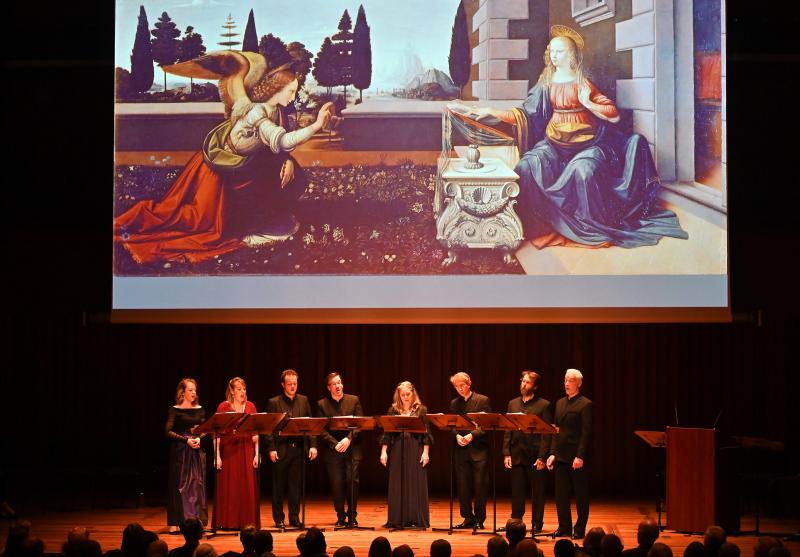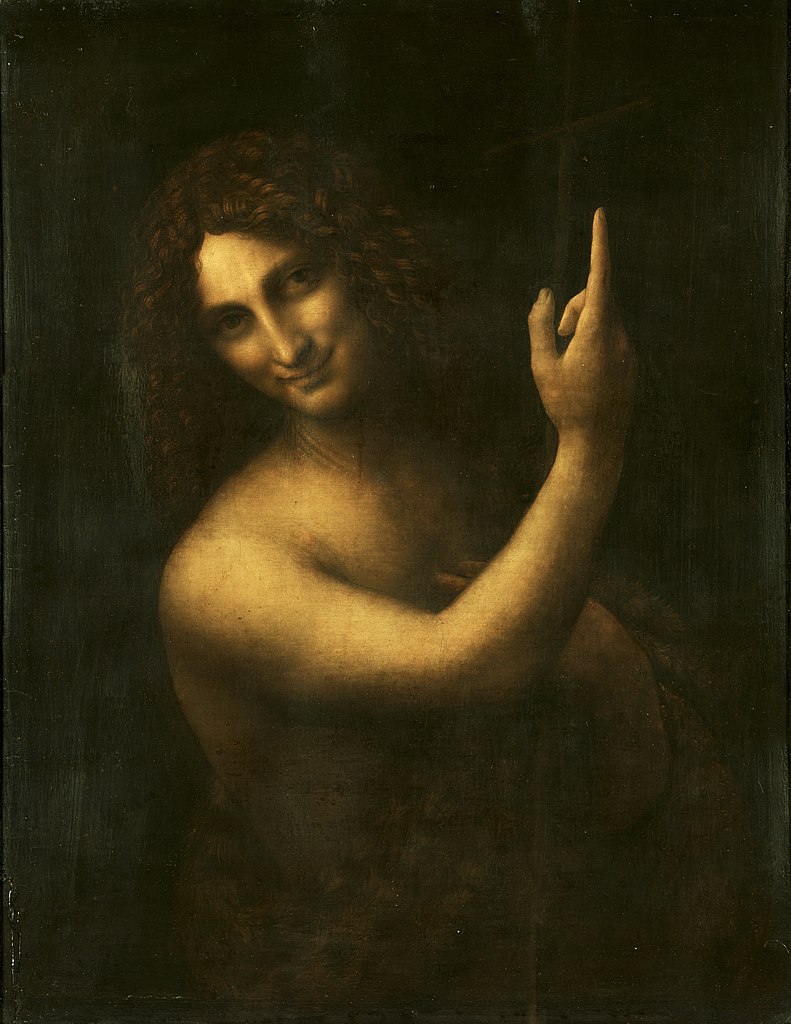I Fagiolini, Hollingworth, St George's Bristol review - Leonardo and music, immortal, invisible | reviews, news & interviews
I Fagiolini, Hollingworth, St George's Bristol review - Leonardo and music, immortal, invisible
I Fagiolini, Hollingworth, St George's Bristol review - Leonardo and music, immortal, invisible
Brilliant polyphony of sound and image, matched and opposed

Having started their tour at the Barbican on Sunday, I Fagiolini descended on Bristol with their Leonardo da Vinci celebration on precisely the 500th anniversary of the great man’s death, a fact that earned them an extra round of applause from the proud but sometimes neglected Bristolians in St.George’s.
How, though, do you celebrate so great a painter through music? The easy answer would be in the music of his day. But I Fagiolini’s director, Robert Hollingworth, and the Leonardo specialist Martin Kemp had a more interesting, perhaps riskier, recipe. They assembled a hybrid programme of vocal consort works ancient and modern, backed them with Leonardo images on a screen, and linked them with commentaries that both implied and deprecated any direct connection. The result was sometimes disconcerting and, at the same time, often brilliant.
Leonardo, a talented man, was himself something of a musician. He invented musical instruments, including one called the lira da braccio, which he learnt to play and on which he would accompany himself singing. But while he revered music as painting’s sister, he regarded its evanescence as a regrettable defect; music fades, only visual art is eternal. Here, of course, he was mistaken. Paintings, being physical objects, decay for good; only music, being intangible, outwits time. Perhaps this was precisely the idea behind the programme’s title, “Shaping the invisible.” In Leonardo the shapes are given, take them or leave them; but the invisible music has to be remoulded every time. And remoulding is very much in I Fagiolini’s line.
 While the images on the screen were the ultimate in refinement, the musical images that accompanied them were sometimes - no doubt deliberately - coarsened. I Fagiolini long ago discarded the English cathedral style of precious polyphonic music, and instead sing it with a somewhat rough edge that goes, maybe, with the idea of Renaissance music as the expression of an age when life was nasty, brutish and short. This can be hard on Josquin Desprez or Victoria, whose vocal writing is of an exquisite precision and richness, if lacking the sensuality that profoundly complicates paintings like La Scapigliata or - as Professor Kemp pointed out - the wonderful John the Baptist in the Louvre (pictured right).
While the images on the screen were the ultimate in refinement, the musical images that accompanied them were sometimes - no doubt deliberately - coarsened. I Fagiolini long ago discarded the English cathedral style of precious polyphonic music, and instead sing it with a somewhat rough edge that goes, maybe, with the idea of Renaissance music as the expression of an age when life was nasty, brutish and short. This can be hard on Josquin Desprez or Victoria, whose vocal writing is of an exquisite precision and richness, if lacking the sensuality that profoundly complicates paintings like La Scapigliata or - as Professor Kemp pointed out - the wonderful John the Baptist in the Louvre (pictured right).
Yet it would be hard to imagine more vivid or dazzlingly uninhibited performances of this difficult music. A great painter may give himself a tough time, but great composers also give their performers one. Tallis’s Salvator mundi is not so demanding, nor as self-important as the painting whose name - though not its monetary value - it shares; nor is Howells’s lovely English setting of the same text. And here the Fagiolini singing was more restrained, very close to perfection in its balanced voicing and coordination. At the other extreme, a chunk of Orazio Vecchi’s L’Amfiparnaso was done as if actually sung by the five grotesques in the Leonardo drawing that provided its backcloth. Luckily it’s a joke that doesn’t outstay its welcome. I wish I could say the same of Janequin’s too long, too arch La Guerre.
Did images and music merge at all elsewhere? Perhaps in Cipriano de Rore’s “Or che’l ciel,” whose mystery was distinctly enhanced, but also modified, by the intense feminine inwardness of “La Scapigliata”. Less so in Monteverdi’s “Era l’anima mia,” which, sung with passion, kept its distance from the Mona Lisa. Perhaps most convincing of all in this respect was an enchanting setting by Adrian Williams of the beautiful poem about bats by Gillian Clarke that gave the programme its title, set against one of Leonardo’s most notorious scientific speculations, glider flight based on the model of bats’ wings. This was shaping the inaudible as much as the invisible, a witty and engaging polyphony of soft close harmony, nocturnal chatterings and - a resource unavailable to painters - silence.
rating
Explore topics
Share this article
The future of Arts Journalism
You can stop theartsdesk.com closing!
We urgently need financing to survive. Our fundraising drive has thus far raised £49,000 but we need to reach £100,000 or we will be forced to close. Please contribute here: https://gofund.me/c3f6033d
And if you can forward this information to anyone who might assist, we’d be grateful.

Subscribe to theartsdesk.com
Thank you for continuing to read our work on theartsdesk.com. For unlimited access to every article in its entirety, including our archive of more than 15,000 pieces, we're asking for £5 per month or £40 per year. We feel it's a very good deal, and hope you do too.
To take a subscription now simply click here.
And if you're looking for that extra gift for a friend or family member, why not treat them to a theartsdesk.com gift subscription?
more Classical music
 Cooper, Hallé, Elder, Bridgewater Hall, Manchester review - a taste of the slightly unexpected
A trusted guide and an imaginative soloist charm the crowd
Cooper, Hallé, Elder, Bridgewater Hall, Manchester review - a taste of the slightly unexpected
A trusted guide and an imaginative soloist charm the crowd
 Hallé John Adams festival, Bridgewater Hall / RNCM, Manchester review - standing ovations for today's music
From 1980 to 2025 with the West Coast’s pied piper and his eager following
Hallé John Adams festival, Bridgewater Hall / RNCM, Manchester review - standing ovations for today's music
From 1980 to 2025 with the West Coast’s pied piper and his eager following
 Kaploukhii, Greenwich Chamber Orchestra, Cutts, St James's Piccadilly review - promising young pianist
A robust and assertive Beethoven concerto suggests a player to follow
Kaploukhii, Greenwich Chamber Orchestra, Cutts, St James's Piccadilly review - promising young pianist
A robust and assertive Beethoven concerto suggests a player to follow
 Robin Holloway: Music's Odyssey review - lessons in composition
Broad and idiosyncratic survey of classical music is insightful but slightly indigestible
Robin Holloway: Music's Odyssey review - lessons in composition
Broad and idiosyncratic survey of classical music is insightful but slightly indigestible
 Classical CDs: Wolf-pelts, clowns and social realism
British ballet scores, 19th century cello works and contemporary piano etudes
Classical CDs: Wolf-pelts, clowns and social realism
British ballet scores, 19th century cello works and contemporary piano etudes
 Bizet in 150th anniversary year: rich and rare French offerings from Palazzetto Bru Zane
Specialists in French romantic music unveil a treasure trove both live and on disc
Bizet in 150th anniversary year: rich and rare French offerings from Palazzetto Bru Zane
Specialists in French romantic music unveil a treasure trove both live and on disc
 Scottish Chamber Orchestra, Ibragimova, Queen’s Hall, Edinburgh review - rarities, novelties and drumrolls
A pity the SCO didn't pick a better showcase for a shining guest artist
Scottish Chamber Orchestra, Ibragimova, Queen’s Hall, Edinburgh review - rarities, novelties and drumrolls
A pity the SCO didn't pick a better showcase for a shining guest artist
 Kilsby, Parkes, Sinfonia of London, Wilson, Barbican review - string things zing and sing in expert hands
British masterpieces for strings plus other-worldly tenor and horn - and a muscular rarity
Kilsby, Parkes, Sinfonia of London, Wilson, Barbican review - string things zing and sing in expert hands
British masterpieces for strings plus other-worldly tenor and horn - and a muscular rarity
 From Historical to Hip-Hop, Classically Black Music Festival, Kings Place review - a cluster of impressive stars for the future
From quasi-Mozartian elegance to the gritty humour of a kitchen inspection
From Historical to Hip-Hop, Classically Black Music Festival, Kings Place review - a cluster of impressive stars for the future
From quasi-Mozartian elegance to the gritty humour of a kitchen inspection
 Shibe, LSO, Adès, Barbican review - gaudy and glorious new music alongside serene Sibelius
Adès’s passion makes persuasive case for the music he loves, both new and old
Shibe, LSO, Adès, Barbican review - gaudy and glorious new music alongside serene Sibelius
Adès’s passion makes persuasive case for the music he loves, both new and old
 Anja Mittermüller, Richard Fu, Wigmore Hall review - a glorious hall debut
The Austrian mezzo shines - at the age of 22
Anja Mittermüller, Richard Fu, Wigmore Hall review - a glorious hall debut
The Austrian mezzo shines - at the age of 22

Add comment